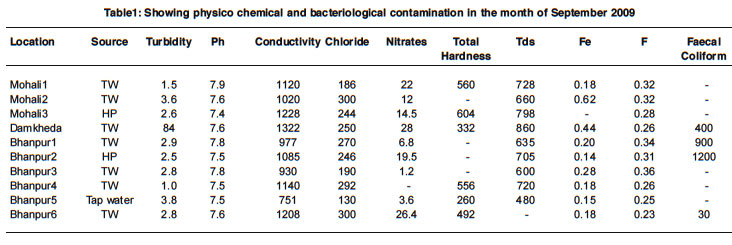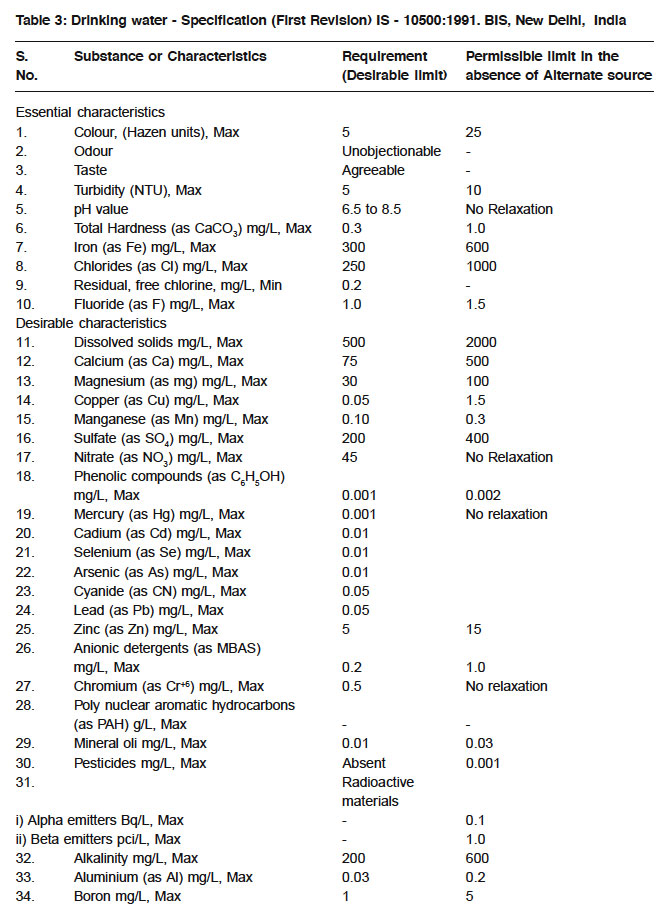Physico-chemical and bacteriological studies of ground water layers in Bhanpur Bhopal (M.P.)
Manisha Sonel1 * , Meena Mourya2 , Sudhanshu Dwivedi3 and D.R. Tiwari4
1
Corporate Institute of Science and Technology,
Bhopal,
India
2
Sagar Institute of Research Technology and Science,
Bhopal,
India
3
Benazir College,
Bhopal,
4
MVM College,
Bhopal,
India
DOI: http://dx.doi.org/10.12944/CWE.5.2.27
Bhopal, the capital city of M.P. is situated amidst the emerald lakes. This paper presents results of physico chemical and bacteriological examination of ground water layers in Bhanpur Bhopal. The study has clearly indicated that the concentration of most of the parameters is below the maximum permissible limits for TDS, alkalinity, Magnesium, chloride, sulphate, and fluoride. The bacteriological contamination at places near Bhanpur which is the dumping site of municipal solid waste was reported and at some places it even exceeded the permissible limits and not suitable for drinking purpose. The sample collection, preservation and pre treatment was according to standard method of collecting samples at international level i.e. BIS procedure. Prior to this a thorough survey conducted to know about probable pollution source and other relevant features.
Copy the following to cite this article:
Sonel M, Mourya M, Dwivedi S, Tiwari D. R. Physico-chemical and bacteriological studies of ground water layers in Bhanpur Bhopal (M.P.). Curr World Environ 2010;5(2):379-382 DOI:http://dx.doi.org/10.12944/CWE.5.2.27
Copy the following to cite this URL:
Sonel M, Mourya M, Dwivedi S, Tiwari D. R. Physico-chemical and bacteriological studies of ground water layers in Bhanpur Bhopal (M.P.). Curr World Environ 2010;5(2):379-382. Available from: http://www.cwejournal.org/?p=1236
Download article (pdf)
Citation Manager
Publish History
Select type of program for download
| Endnote EndNote format (Mac & Win) | |
| Reference Manager Ris format (Win only) | |
| Procite Ris format (Win only) | |
| Medlars Format | |
| RefWorks Format RefWorks format (Mac & Win) | |
| BibTex Format BibTex format (Mac & Win) |
Article Publishing History
| Received: | 2010-04-12 |
|---|---|
| Accepted: | 2010-06-17 |
Introduction
Water is essential for life on earth. Water is a unique liquid, without it life is impossible. The importance of ground water for the existence of human society cannot be overemphasized. Ground water is the major source of drinking water in both urban and rural areas. Besides, it is an important source for the agricultural and the industrial sector. As far as the quality of ground water is concerned, many places including Bhopal have been identified as endemic to contamination due to disposal of untreated solid waste at the disposal site of Bhanpur Bhopal.
Water extraction without proper recharge and leaching of pollutants has polluted ground water supplies. In addition, leachates from agriculture, industrial waste and mainly the municipal solid waste have been polluted surface and ground water.
Water pollution refers to any type of aquatic contamination rendering the water body poisoned by toxic chemicals and pathogenic micro organisms which affect living organisms and all forms of life.
To study the extent of pollution in ground water, we have selected ground water bodies at Bhanpur Bhopal which is the disposal site of municipal solid waste.
Material and Methods
Bhopal city is situated close to the geographical centre of the country between 23º 35’N latitude and 77° 23’ E longitudes. The area of the city is 285 sq.km with maximum altitude of 625m above sea level.
The ground water bodies of Bhanpur Bhopal have been surveyed throughout the year. Few sampling sites were selected where municipal solid waste is disposed off without any scientific treatment.
It has been observed that in the areas near Bhanpur, hand pump is the only source of drinking water; few places like Mohali, Patel nagar, Bhanpur under bridge area, Damkheda were selected for sampling of potable water. The samples were collected from the study area and were analyzed for turbidity, ph, conductivity; chlorides, nitrates, total hardness, TDS, iron, fluoride and bacteriological analysis include detection of faecal coli form by following standard techniques as per BIS-10500 for drinking water requirement.
 |
Table 1: Showing physico chemical and bacteriological contamination in the month of September 2009 Click here to view table |
 |
Table 2: Showing physico chemical and bacteriological contamination in the month of March 2010 Click here to view table |
Drinking water – specification Bacteriological Examination Water in the distribution system
Ideally, all samples taken from the distribution system including consumers’ premises should be free from coli form organisms. In practice, this is not always attainable, and the following standard of water collected in the distribution system is therefore recommended when tested in accordance with IS 1622:1981.
a) Throughout any year, 95 percent of samples should not contain any coli form organisms in 100 mL;
b) No sample should contain E. coli in 100 mL;
c) No sample should contain more than 10 coli form organism per 100 mL; and
d) Coli form organism should not be detectable in 100 mL of any two consecutive samples.
Source: Indian standard drinking water - specification (First Revision) IS-10500:1991. BIS, New Delhi, India
 |
Table 3: Drinking water-Specification (First Revision) IS-10500:1991. BIS, New Delhi, India Click here to view table |
Results and Discussion
The data revealed that the various physic chemical parameters were determined as per methods suggested by BIS-10500 and they were found to be under permissible limit but as shown above when we compare analysis reports of samples with drinking water specifications some parameters like turbidity, nitrates, total hardness and iron content of some samples are beyond permissible limits and the bacteriological analysis report of some of the samples of water was found to be contaminated.
The safety and acceptability of many widely used solid waste management practices are of serious concern from the public health point of view. All wastes produced were handled by their producers using simple disposal methods including terrestrial dumping in to both fresh and marine waters and uncontrolled burning. Inspite of ever increasing industrialization and urbanization the dumping of solid waste, particularly in landfills remains a prominent means of disposal and implied treatment.
Alternative treatment technologies for solid waste management include incineration with heat recovery and waste gas cleaning and accelerated composting but both of these technologies are subject to criticism either by environmentalists on the grounds of possible hazardous emissions, failure to immobilize heavy metals by land fill operations, while key question concerning the effects of the various practices on public health and environmental safety remain unanswered.
References
1. Indian Standard specification for drinking water IS-10500-1983
2. APHA Standard method for the examination of water and waste water
3. Prati L.R. Paenello and F. pesarin assessment of surface water quality by a single index of pollution. Wat Res. 5.
4. Indian journals.com






